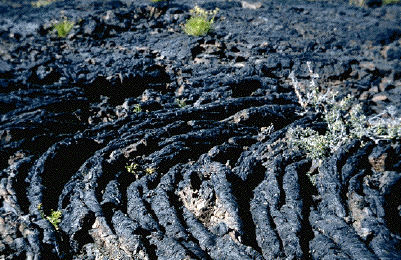Igneous Rocks
Physical Geology

Ropy Lava Flows - Craters of the Moon
I hate "blinking text" but it did catch your attention. I am interested in finding out more about you and your backgrounds. Therefore, if you will complete the following Survey by the end of September, 2001, you will earn 10 points.
Each chapter in this Internet Resource Guide for Physical Geology begins with a link in the chapter title. These resources were chosen to provide broad overviews for the chapters.
You may wish to print a copy of the lecture outline (minus the illustrations) and you have two options:
Chapter Objectives
After reading the chapters on Igneous Processes and Rocks you should be able to:
- Distinguish magma vs. lava, intrusive vs. extrusive, and plutonic vs.
volcanic.
- Explain Bowen's reaction series and magmatic differentiation.
- Explain how igneous rocks are named, based on composition and
texture.
- Distinguish between granitic, andesitic, and basaltic rocks.
- List and describe the types of igneous plutons.
- Explain the importance of viscosity and dissolved gasses in volcanic
eruptions.
- List the types of volcanoes, their physical features, and their lava types.
- Describe the relationship between volcanoes and plate tectonics.
Introduction
The study of igneous activity requires understanding processes initiated at depth and at temperatures high enough to produce liquids (magmas). In general, both temperature and pressure increase with increasing depth and it is the rate of increase that is important.
The geothermal gradient measures the rate at which temperature increases within the Earth. Near surface studies indicate that the geothermal gradient is about 30 o C per kilometer.
Internet Resources
- Granites
Granites constitute (for the most part) the continental crust.
"a very hard natural igneous rock formation of visibly crystalline texture formed
essentially of quartz and orthoclase or microcline and used for building and for
monuments 2: unyielding firmness or endurance
[Why is granite like ice cream?]
- Review - Mantle Convection
- Meteorites
Although not all meteorites are of igneous origin, many appear to have crystallized from a melt.
"The term meteor comes from the Greek meteoron, meaning phenomenon in the sky. It is used to
describe the streak of light produced as matter in the solar system falls into Earth's atmosphere creating
temporary incandescence resulting from atmospheric friction."
- Volcanism in the Cascades
Your semester project involves the geology of the Cascade Mountains. Here is a place to get started.
A Virtual Field Trip to the Mount Airy Granite Quarry
Granites and other igneous rocks are often used in the construction industry and for decorative facings, monuments and memorials. The Mount Airy Granite Quarry virtual field trip provides a good introduction to this topic.
"The town of Mount Airy is located in
the northwestern part of North Carolina
and is home to the largest open-faced
quarry in the world. The North Carolina
Granite Corporation has been quarrying
white granite at this location since 1904, but the history of the quarry goes back
even farther than that."
Learning about geology from a computer screen is only half as fun as enjoying it in the field!
_________________________________________________________________________________________________
| jbutler@uh.edu
|E-mail the ClassListserv|Read the ClassListserv|
|Textbook Home Page
|Glossary of Geologic Terms|Search These Pages|
|Other Courses|Resources|Grade Book|
_________________________________________________________________________________________________
Copyright by John C. Butler, July 29, 1995
